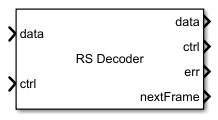RS Decoder
Decode and recover message from RS codeword
Libraries:
Wireless HDL Toolbox /
Error Detection and Correction
Description
The RS Decoder block decodes and recovers a message from a Reed-Solomon
(RS) codeword. The block accepts codeword data and a samplecontrol bus and
(optionally) erasure and outputs a decoded message data, a samplecontrol
bus, whether the received data is corrupted, a block ready indicator, and (optionally) the
number of corrected errors. The block provides an architecture suitable for HDL code
generation and hardware deployment and supports shortened message lengths.
Because, the latency of the block varies, the block provides output port nextFrame that indicates when the block is ready to accept new input codeword data. For more details about latency, see the Algorithms section.
You can use this block to model many communication system forward error correcting (FEC) codes. The block supports digital subscriber line (DSL), WiMAX (802.16 m and e), digital video broadcast handheld (DVB-H) terminals, digital video broadcast satellite (DVB-S) services, and digital video broadcast satellite services to handheld (DVB-SH) devices below 3 MHz.
Examples
Ports
Input
Output
Parameters
Algorithms
References
[1] Wicker, Stephen B. Error Control Systems for Digital Communication and Storage. Englewood Cliffs, NJ: Prentice Hall, 1995.
[2] Berlekamp, Elwyn R. Algebraic Coding Theory. Revised edition. McGraw-Hill Series in Systems Science. New Jersey: World Scientific, 2015.
[3] Clark, George C., and J. Bibb Cain. Error-Correction Coding for Digital Communications. Applications of Communications Theory. New York: Plenum Press, 1981.
[4] Moon, Todd K. Chapter 6, Error Correction Coding: Mathematical Methods and Algorithms. Hoboken, N.J: Wiley-Interscience, 2005.
[5] Chien, R. “Cyclic Decoding Procedures for Bose- Chaudhuri-Hocquenghem Codes.” IEEE Transactions on Information Theory 10, no. 4 (October 1964): 357–63. https://doi.org/10.1109/TIT.1964.1053699.
[6] Forney, G. “On Decoding BCH Codes.” IEEE Transactions on Information Theory 11, no. 4 (October 1965): 549–57. https://doi.org/10.1109/TIT.1965.1053825.



